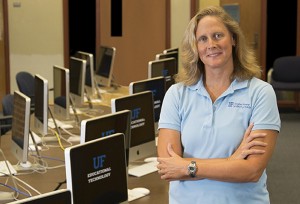Posts
Learning Gains from our Brains
Faculty scholars are merging neuroscience and education research to personalize multimedia and online learning
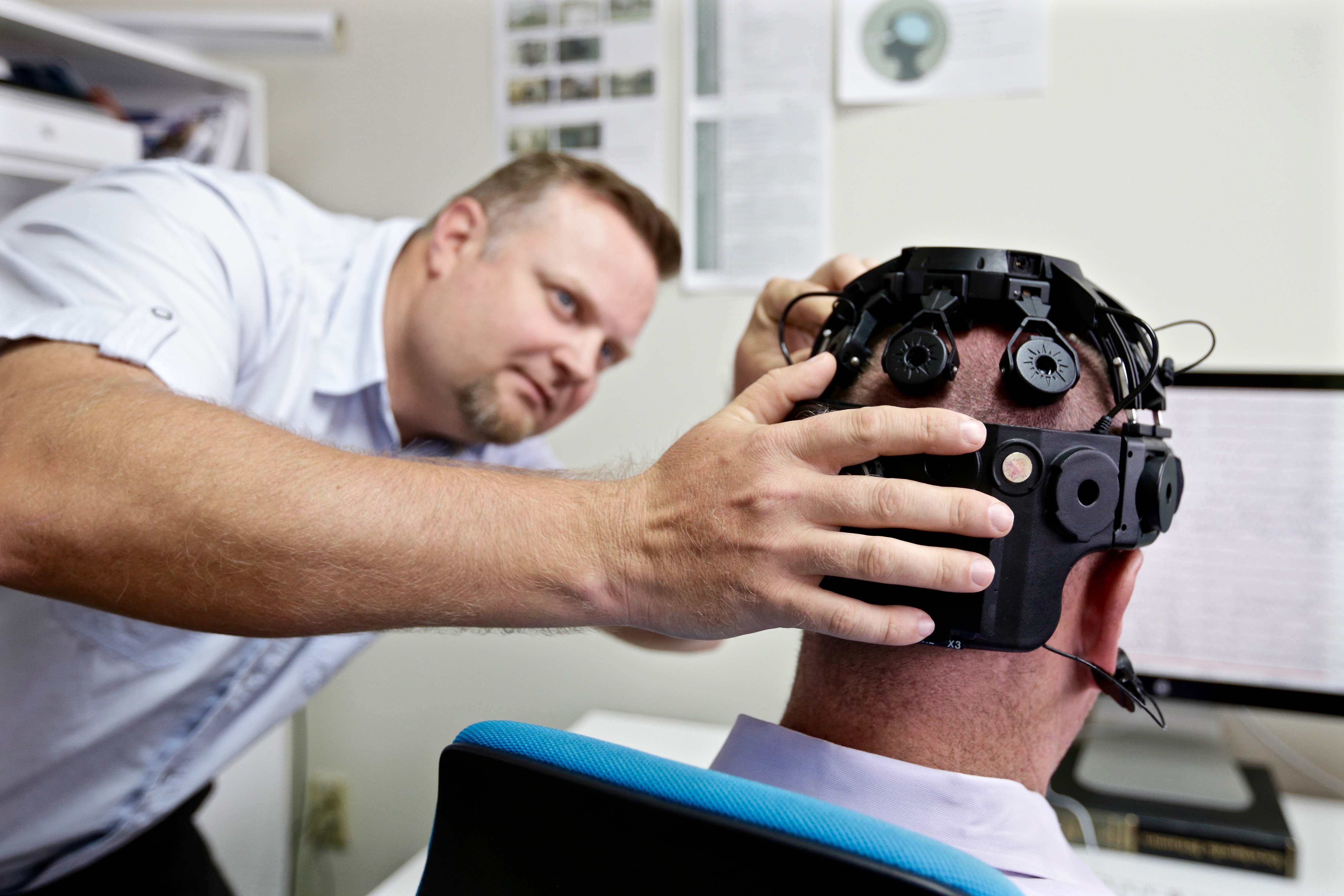
UF education technology researcher Pavlo “Pasha” Antonenko adjusts his EEG headwear on a study subject.
UF education technology researcher Pavlo “Pasha” Antonenko has never been afraid to take risks and go against convention. His pioneering spirit emerged in the 1990s in his Ukraine homeland, where personal computers were scarce and there was no internet connection. Fast forward two decades, to today, and you’ll find him leading groundbreaking studies at the College of Education on a radical new approach for advancing and personalizing the still-fledgling field of online learning.
SETTING THE STAGE
Antonenko’s journey to UF started in the late 1990s when he was a high school teacher. He became fascinated with computers at a time when his hometown of Nizhyn, Ukraine had no internet connections and few computers. He began building and selling computers to supplement his income while he earned a master’s in linguistics in English and German languages.
“I was one of the first people in my hometown to get an internet connection, but it wasn’t very good. I started building websites even before I had internet, but they were just sitting on my computer,” he recalls.
His career path changed dramatically in 2002 when he traveled to Orlando to work as an interpreter at a conference on education technology, a discipline that wasn’t even recognized in Ukraine. But Antonenko had found his passion: exploring ways computer technology can improve education.
“Everything I heard there and the people I met, I said ‘wow, this is what I want to do as my graduate education and job,’” he says.
Within a few months, he and his wife, Yuliya, moved a half-world away to settle in Ames, Iowa, where he spent five years at Iowa State University earning a doctorate in curriculum and instructional technology and human-computer interaction.
Along the way, Antonenko worked with Iowa State neuroscientists on one of his personal research interests—the use of electroencephalography (EEG) to monitor brain activity known as “cognitive load,” which is the amount of mental effort expended by the working memory during a learning task. EEG, which records the brain’s electrical activity, is most commonly used in medicine as a first-line, non-invasive method of diagnosing stroke and other brain disorders.
It would have been intriguing to monitor Antonenko’s own brain activity as he thought to himself, “Hmmm, I wonder if EEG might be a reliable way to study the mental processes underlying learning.” He wrote his dissertation on the topic and became one of the first education researchers to use EEG to measure the cognitive dynamics of learning.
The stars begin to align
After earning his doctorate and serving five years on the education technology faculty at Oklahoma State University, Antonenko joined UF’s ed. tech faculty in 2012. His appointment coincided with the education world’s identification of personalizing online learning as a global challenge and a top research priority of the U.S. Department of Education and the National Science Foundation.
UF administrators also targeted research of personalized e-learning for investment of state “preeminent university” funds, which enabled the College of Education in 2014 to recruit top ed. tech scholar Carole Beal from Arizona State University, where she was conducting her own pioneering neuro-education studies. Beal became the first director of UF’s new campuswide Online Learning Institute.
The College of Education made a priority of integrating neuroscience with education research to improve online learning at all levels. Pivotal developments during the 2015-16 academic year made that push a certainty.
Merging Neuroscience and education research at UF
In 2015, Antonenko, Beal and UF education technology colleague Kara Dawson attracted vital grant funding to lead novel interdisciplinary research projects using wireless EEG brain monitoring and other neuro-technology to study how multimedia learning can be impoved for all students, not just those who test well on academic exams. These studies focus on education in the STEM disciplines—science, technology, engineering and math—areas in which the use of multimedia learning tools “has far outstripped the ability of research to keep pace with,” says Antonenko.
Their focus on custom-tailoring instructional design for individual learner differences, rather than a “one-size-fits-all” approach, is a distinctive feature of their studies.
“Virtually all research on multimedia learning methods has been performed on high-achieving students at elite research-intensive universities, where studies like this usually occur. We are evaluating these methods with more diverse student populations and those with special needs,” Antonenko says.
FAST FACT:
In 2015, Antonenko became the first UF education faculty researcher to win 5 NSF grants in the same year.
NSF study focuses on community college students
Antonenko heads a team of highly specialized researchers drawn from multiple institutions on a three-year study, supported by a $765,000 grant from the National Science Foundation. The researchers are gauging how effective technology-assisted learning practices are for a diverse group of community college students, which now constitute nearly half of all U.S. higher education students.
The team, dubbed the Science of Learning Collaborative Network, includes top scholars in education technology, neuroscience, STEM education, neuropsychology, computer science and educational measurement. They hail from UF, the University of Massachusetts-Boston and Washington State University.
Some 120 students from three colleges—Santa Fe College in Gainesville, Bunker Hill Community College in Boston and SUNY Buffalo State in Buffalo, N.Y.—are participating in the study. The students are screened for demographics and learning differences, such as working memory and visual attention levels, to ensure a varied test group.
Team specialists in cognitive neuroscience are employing EEG and other high-tech methods, including functional near infrared spectroscopy (to measure neural changes in blood oxygenation) and eye tracking (to understand visual attention) to assess the students’ attention and mental processes while they learn using multimedia materials that include text, images, videos, animations and audio.
The researchers hope to land follow-up NSF grants by demonstrating the effectiveness of their network’s organization, infrastructure and integration of diverse research strategies, along with their unique approach to personalized learning.
“Working with scholars from other disciplines and other institutions is really exciting but it’s also challenging because each discipline and each person has a different way to work,” Antonenko says. “We have to make sure everyone is invested and feels valued and make sure we pull all of the expertise together in a way that makes sense.”
UF co-researchers are ed. tech faculty members Dawson and Beal, and psychology professor Andreas Keil. Co-principal investigators are computer science and STEM education scholars Matthew Schneps from Massachusetts Institute of Technology and Marc Pomplun from the University of Massachusetts-Boston, and Richard Lamb of SUNY Buffalo State, who focuses on science education and measurement.
Adapting digital media for students with dyslexia
Professor Dawson heads an educational neuroscience study focused on multimedia learning for students with dyslexia, the most common language-based disability. People with dyslexia typically have difficulty reading and processing words.
Dawson was awarded $85,000 for the one-year project from UF’s Office of Research, which awards Research Opportunity Seed Fund grants to UF scholars for the merit and potential of their research proposals. Antonenko is a co-principal investigator.
The study involves 72 college students with dyslexia, each participating in one of four multimedia learning settings while wearing wireless EEG headsets to monitor and record brain activity during the multimedia exercise and comprehension assessment. The student volunteers are drawn from four institutions: Santa Fe Community College and the universities of Central Florida, North Florida and South Florida.
While neuroscience-based methods are central to the study, Dawson is quick to make one thing clear: “In no way am I a neuroscientist.”
“To me, this is not about neuroscience,” she says, “I am interested in what neuroscience techniques can tell us about the learning process. That is what it’s all about for me.”
Dawson and her team will use their findings to evaluate the validity of merging EEG and behavioral measures and, ultimately, to develop new instructional strategies and materials that teachers can personalize for individual students with varied learning traits and backgrounds.
Besides Dawon and Antonenko, the research team includes UF ed. tech colleagues Beal and Albert Ritzhaupt, dyslexia diagnostic specialist Linda Lombardino from UF’s special education program, and UF neuropsychologist Keil. Doctoral students participating are Kendra Saunders from school pyschology and Nihan Dogan, Jiahui Wang, Li Cheng, Wenjing Luo and Robert Davis from the School of Teaching and Learning. Matthew Schneps from the Harvard-Smithsonian Center for Astrophysicists also is collaborating.
“We all share this mutual goal of figuring out how technology can help all types of learners,” Dawson says. “We need to make technology work so everyone feels they can learn and be smart and successful.”
MUCH PROMISE BUT NOT YET READY FOR PRIME TIME
The researchers describe both educational neuroscience studies as exploratory, but Antonenko says he expects them to yield solid preliminary findings that may lead to follow-up NSF research proposals.
“EEG appears to be a great tool for educational research that can produce important implications for teaching and learning in education.” he says. “Our focus is on helping people who need additional support as they learn using 21st century online and multimedia tools in education.”
“That is what I find most rewarding.”
WRITER: Larry Lansford, communications director, UF College of Education; 352-273-4137; llansford@coe.ufl.edu
Q & A with Kara Dawson on closing the ‘digital divide’
It was in 1990 when Kara Dawson gained an insight that was to become the central focus of her research career as a professor of educational technology.
Back then she was teaching 5th, 6th and 7th graders in Virginia Beach, Virginia, at a time when personal computers were just catching on and the invention of the first internet browser was three years away. Dawson attended a workshop on authoring software and began experimenting with using technology in her classroom as a way to engage struggling students.
Fien Professorship boosts Dawson’s research and teaching
Kara Dawson received the College of Education’s Irving and Rose Fien Professorship for 2015-2018.
The professorship provides:
- $15,000 annual research fund
- A half-time research assistant
- $15,000 annual salary supplement
The grant is helping to advance Dawson’s research to promote technology use for all students, including:
- Creating a network of teacher fellows to engage in a study of technology practices in classrooms.
- Coordinating an annual interactive lecture series on the topic to connect a community of interested individuals.
- Supporting doctoral students interested in this area through travel funds and other opportunities.
She soon came to see that educational technologies could improve the learning outcomes for virtually all students. She became her school’s technology integration specialist and in 1994 she returned to college to earn a doctorate in the emerging field of instructional technology from the University of Virginia.
In 1999, she came to the University of Florida’s College of Education and has served as coordinator for the educational technology program and co-developed five advanced degree programs, both online and for the classroom. Her many research projects have included:
- Evaluating the effectiveness of multimedia and mobile apps for dyslexic schoolchildren
- Studying how students with different cognitive profiles learn in multimedia environments
- Investigating a growing “digital divide” whereby middle-school students’ socioeconomic status, gender and ethnic background affect their computer savvy
Last year, the College of Education’s Research Advisory Committee selected Dawson as its Irving and Rose Fien Professor. The three-year post supports veteran faculty members with a track record of successful research aimed at helping at-risk learners in kindergarten-through-high school, mainly at high-poverty schools.
Recently, Dawson took time to discuss her research and the ways incorporating technology and digital tools into traditional classrooms can help all types of learners to flourish. Below are excerpts.
Q: Can technology help students who struggle in traditional schools?
A: Yes, particularly if they are bored, not engaged or struggling to learn content. In schools, we are very limited in how we think about success and the way that students can access content and show what they know. We are also limited in the ways we think about how we teach. These limitations are very real and exist for many reasons often outside the direct control of individual teachers and administrators. But we should keep thinking about how to make school better for all students. Technology is not going to be the end-all-be-all solution, but it can help a lot more than it is helping.
Q: These multimedia tools may get them more engaged?
A: Yes, but we need to figure out how to match technologies to students. And how to match students to technologies. More importantly, students have to be empowered to think about what works for them and to seek alternatives to support their learning now and in the future.
Q: Can you provide examples of how technology can be useful in a classroom?
A: Well, there are a lot of ways technology can be useful in the classroom. I have done quite a bit of work with whole class projects that help students become digital communicators, creators and collaborators. But these uses are different from thinking about how technology can meet individual needs. Two simple, readily available tools are: text-to-speech and speech-to-text apps.
Q: With speech-to-text, you mean there is a web page or a textbook that is enabled to read the text to a student?
A: Yes. For example, for a student struggling to get through a 40-page chapter on U.S. history, text-to-speech could be the difference between accessing the content or not. For another student listening to the chapter may simply be a preference rather than a necessity. But, the types and quality of the technologies available to these students as well as the mindset of their teachers determine whether they can use this feature. Unfortunately, many digital resources created for K-12 education are poorly designed (especially some digital textbooks) and some educators still view reading as the only way to access content. So, the apps may be simple but the context in which they need to be used is quite complex.
Two other examples are speech-to-text and word prediction. I once taught a student who was very articulate but with horrible handwriting. Why not let him communicate his ideas through speech-to-text apps? Why not teach students who struggle with spelling (or really all students) how to use word prediction? Once again, these are simple apps, but the challenge is how do you bring them to the complex world of K-12 education.
Q: Let me take a devil’s advocate position. How do you respond to those who say kids need to learn how to spell, that we shouldn’t have a tool to do it for them?
A: Don’t get me wrong, it’s important that students to learn to spell. But not everyone is going to be good at it and this shouldn’t deter students from being able to communicate their ideas. It shouldn’t continually hinder them from succeeding in school, especially when the goal of a particular learning task may not be focused on spelling.
Q: Is this a big debate in education, one with parents and others, that there is work to do to get this message out?
A: There needs to be some empathy and understanding that being smart is not equivalent to being able to read and write. Think about it, students who struggle with reading, writing and spelling are essentially doomed in a school environment if learning every subject is predicated on these three skills.
Imagine if we gauged how smart you were based whether you could communicate through song. And so everyone who had a good voice and was gifted in that way would shine. Or what if we communicated everything through drawing? So it’s just a very limited way we think about things.
If a student cannot read well (or quickly) and all content is provided through a textbook then she will struggle to learn science and history even if she has innate strengths in other areas, such as the visuospatial strengths needed to succeed in science. Technology can level the playing field for these students.
Q: As far as the Fien Professorship, what do you hope to accomplish over these three years?
A: I really hope to make progress on the ways we can use technology to support the needs of all learners.
I am involved with two studies about how nontraditional college students learn in multimedia environments. We hope to find out how multimedia and online environments can be modified to meet the needs of different kinds of learners and extend our work to K-12 students. One of the most exciting things is that these studies require interdisciplinary collaboration. We need the expertise of special educators, psychologists, computer scientists and neuroscientists. And, I get to work with closely the exceptionally smart colleagues in my own program as well — Albert Ritzhaupt, Pasha Antonenko, Carole Beal and Swapna Kumar.
I also want to make an impact people’s awareness about how technology can meet the needs of all learners. In particular, I plan to work with and learn from teachers who are trying to figure out how to use technology to help their students and with preservice teachers. They have the chance to be leaders in their schools after graduation.
And I’m working with a grassroots group of parents led by Blake Beckett (from P.K. Yonge, the College of Education’s developmental research school) to find ways parents can use technology to support their children.
There are several potential funding sources to further this work and I’m looking forward to see where these ideas and conversations go.
Q: Does it feel daunting with such a big subject? There seems so much to learn.
A: I know I’m not going to solve it; there are so many folks from so many areas trying to make a difference for students. I want to do what I can do and try to make things better and connect with other people who are doing interesting work. I don’t consider it daunting because I’m not naïve enough to think it’s going to ever be completely solved but I want to make progress and be part of the solution.
Source: Kara Dawson, 352-273-4177
Writer: Charles Boisseau, 352-273-4449
‘Global classrooms create worldly connections for future teachers
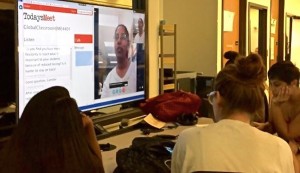
COE preservice teachers interact on Skype with alumna Luz Delfin, currently teaching at the American School in Bolivia.
University of Florida education students are using technology to connect with educators and classrooms worldwide to learn about other cultures and education systems first-hand thanks to a new Global Classroom Initiative (GCI) developed by UF researchers.
Swapna Kumar, a clinical associate professor of educational technology in the College of Education, said the program prepares preservice teachers to use technology to develop global awareness for themselves and their future students. It also provides opportunities for students to participate in virtual conferences and interact with innovative global educators.
The program is funded by a grant from the Longview Foundation for World Affairs and International Understanding, an organization that promotes the teaching of global competence and intercultural skills in schools throughout the United States.

Swapna Kumar
Seventy UF education students have benefited from the initiative since it was launched last fall through online modules in the college’s course on Integrating Technology into the Elementary Classroom.
Skype and Adobe Connect are two programs used by the future teachers to connect classrooms across borders. They will have access to Skype in their future classrooms, both stateside and in other countries.
“Communication technologies today make it much easier to provide students with authentic experiences of other cultures,” Kumar said.
Elementary education senior Heather Brown said the program has helped her understand the importance of global education.
“The Global Classroom Initiative is educating me further and giving me invaluable experiences that will help me grow as a teacher so that I can have a lasting impact on my students,” said Brown, who will graduate with her bachelor’s degree in May.
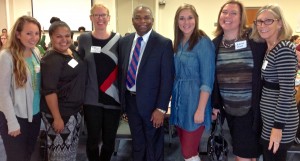
UF Global Classroom students also joined their instructor at the Florida Connected Global Education Conference held recently in Gainesville as another form of future teacher professional development.
Kumar is co-principal investigator on the program with Mary Risner, associate director of outreach at the UF Center for Latin American Studies. They said they hope the global classroom instruction will prepare UF’s education students to possibly work with the Alachua County school district’s first global magnet program planned for Fall 2017 and in other districts some students will teach after graduation.
“In today’s society, teachers need to be prepared to understand a diverse student body and to help their students better understand the world with an open mind,” said Risner, a 2011 COE doctoral graduate in curriculum and instruction.
She said UF students explore global themes in the GCI modules, connect with educators in Bolivia and Japan, prepare a lesson plan for elementary students about foreign nations and learn about job and study opportunities abroad.
CONTACTS/CREDITS
SOURCE: Swapna Kumar, UF College of Education; 352-273-4175; swapnakumar@coe.ufl.edu;
MEDIA LIAISON: Larry Lansford, news & communications director, UF College of Education; 352-273-4137; llansford@coe.ufl.edu;
WRITER: Katelin Mariner, news-communications intern, UF College of Education
Ed. technology researcher lands record five NSF grants
Jan. 26 Update: NSF announces fifth grant, $1.2 million, for Dr. Pasha Antonenko to lead UF team on 3-D paleontology technology project.
GAINESVILLE, Fla. — Pasha Antonenko, an associate professor of educational technology, has set a new standard at the University of Florida College of Education, scoring five research grants from the National Science Foundation — all in the same 2015 funding cycle.
“You don’t expect all of them to hit,” Antonenko said. “You are lucky if one grant proposal is funded because acceptance rates are so low.”
Thomasenia Adams, associate dean of educational research, said five NSF awards sets a single season record for grants awarded to a College of Education faculty researcher.
“Dr. Antonenko has blazed the trail we have not seen before,” Adams said.
The National Science Foundation is an independent federal agency, created by Congress in 1950, that funds nearly one-fourth of all basic research conducted by America’s colleges and universities. It’s the only federal agency that supports all fields of fundamental science and engineering, except for the medical sciences.
Even more impressive than the number of NSF grants Antonenko received may be the variety and importance of the topics to be addressed in the resulting studies.
Antonenko’s five NSF awards total $4.1 million and will fund novel research projects using a wide-range of technologies in learning applications, including 3-D scanners and printers to study prehistoric bones, drones to study construction projects, and computerized simulations to study the human body’s reactions to a wide-range of stimuli.
He specializes in exploring the promise and problems of educational technology, including human-computer interaction and the design of learning environments.
The Ukrainian-born scholar will work with dozens of collaborators across the country, including researchers from fields as varied as construction engineering and paleontology and from institutions from Arizona to Massachusetts, as well as the University of Florida.
Antonenko is principal investigator on three of the NSF grants and co-principal investigator on two, one of which is led by UF’s David Julian, associate professor of biology, and the other by Emily Sessa, UF assistant professor of biology.
Below is a rundown of the NSF projects Antonenko will be working on.
• Creating an evolutionary history of earth’s oldest plants: a $1.8 million, four-year project. With Sessa as principal investigator, the research team is developing a history of the evolution of flagellate plants — the oldest known land-based fauna to ever have existed, such as ferns. Other co-principal investigators are UF biology scholars Gordon Burleigh, Stuart McDaniel and Christine Davis. Antonenko’s role is to lead the development of an online application, named Voyager, to allow university students to explore a massive database in classrooms and promote evidence-based teaching practices. Antonenko will measure the effectiveness of the learning by conducting tests, including using electroencephalograms (EEGs), which measure the electrical activity in the brain of students to determine how well they are learning.
• STEM teaching using 3-D scanners and printers: This three-year, $1.2 million project will allow middle- and high-school students to study and scan bones in three dimensions, and upload them to virtual collections that scientists can access worldwide and reproduce using 3-D printers. Antonenko said the team is seeking to address an ongoing problem in 21st century education: how to integrate STEM (science, technology, engineering and math) lessons across multiple disciplines.
• How community college students learn using multimedia: a three-year,$765,000 effort. The use of multimedia resources in STEM education has undergone remarkable growth in recent years. The problem: Most all research on the effectiveness of these tools has been performed on high-achieving students at elite universities. This study will look at how effective these tools are among more diverse community college students, which now constitute nearly 50 percent of the population of higher education students. Co-principal investigators from UF are education technology faculty researchers Carole Beal (who also heads UF’s new Online Learning Institute) and Kara Dawson, and Andreas Keil, associate professor of psychology.
• Creating an application to teach human physiology: a two-year, $247,129 project. Pre-med and other university students studying human physiology will use a new computer-based tool, called HumMod, to find out how a particular variable will affect a person’s health. For example, if a 50-year-old man were exposed to a certain level of carbon monoxide, how would that affect his cardiovascular, respiratory, neural and other processes? This study, led by UF’s Julian, allows for research of more than 6,000 variables to predict physiological responses.
• Using drones to study construction and engineering projects: This one-year, $58,148, pilot trial will use drones equipped with video cameras so students can view structures that are under construction. It seeks to address the problem in construction engineering and management courses of how to show students the myriad ways to build increasingly complex projects in a variety of scenarios, such as on all manner of construction sites. It’s not practical for students to take field trips to see these projects. “Cyber-Eye” will allow them to view drone-shot videos and establish a case library to see how to tackle real-world construction issues.
With this, as with as all his projects, Antonenko is looking to solve problems by using new ways of teaching and learning.
“In essence, all of the projects are about my core research, which really is understanding learning from different perspectives,” he said.
CONTACTS
SOURCE: Pasha Antonenko, UF College of Education; 352-273-4176; p.antonenko@coe.ufl.edu
WRITER: Charles Boisseau, UF College of Education; 352-273-4449; cboisseau@coe.ufl.edu
MEDIA LIAISON: Larry Lansford, communications director, UF College of Education; 352-273-4137; llansford@coe.ufl.edu
Ed. tech’s online master’s program ranked 9th in U.S.
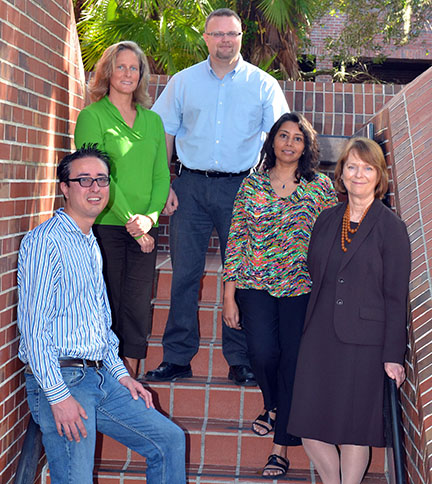
Faculty members of the College of Education’s online education technology master’s degree program include, from left to right, Albert Ritzhaupt, Kara Dawson, Pavlo “Pasha” Antonenko, Swapna Kumar and Carole Beal.
The UF College of Education’s online master’s degree program in education technology – which provides education professionals with the knowledge and expertise needed to use educational technologies to improve learning and performance in face-to-face, online and blended environments — has joined the COE’s education leadership online graduate program on a list of top 10 rankings nationwide.
TheBestSchools.org, a higher education website for college information seekers, recently placed the education technology program at No. 9 on its list of “The 25 Best Online Master in Educational Technology Degree Programs” — just weeks after giving the COE’s education leadership program a No. 5 ranking in its specialty area.
The site also ranks the University of Florida’s overall distance learning program at No. 2 in the nation behind the Penn State World Campus. Rankings for the two online master’s programs are based on academic excellence, range of available classes, faculty strength, other rankings and reputation.
Meanwhile, education leadership faculty member Bruce Mousa, who helped establish the online education leadership master’s degree program two years ago, has been using his program’s No. 5 ranking as a marketing tool.
“We tell everyone that we’ve got a flexible, online course that maintains high standards set by UF,” said Mousa, whose program prepares working teachers and other professionals to become school principals.
The complete rankings can be found online at http://goo.gl/mrRzKZ.
Contacts
Source: Albert Ritzhaupt, UF associate professor of education technology; phone (352) 273-4180; aritzhaupt@coe.ufl.edu.
Liaison: Larry Lansford, director, College of Education Office of News and Communications; llansford@coe.ufl.edu; phone 352-273-4137.
Writer: Stephen Kindland, College of Education Office of News and Communications; skindland@coe.ufl.edu; phone 352-273-3449.
Breast cancer doesn’t stop ed tech student from earning her doctorate
Chemotherapy, a double mastectomy, reconstructive surgery and a regimen of pills to counteract the side effects of other prescriptions couldn’t stop Johanna “Jo” Kenney from earning her doctorate in education technology from UF while holding down a full-time job—in Texas.
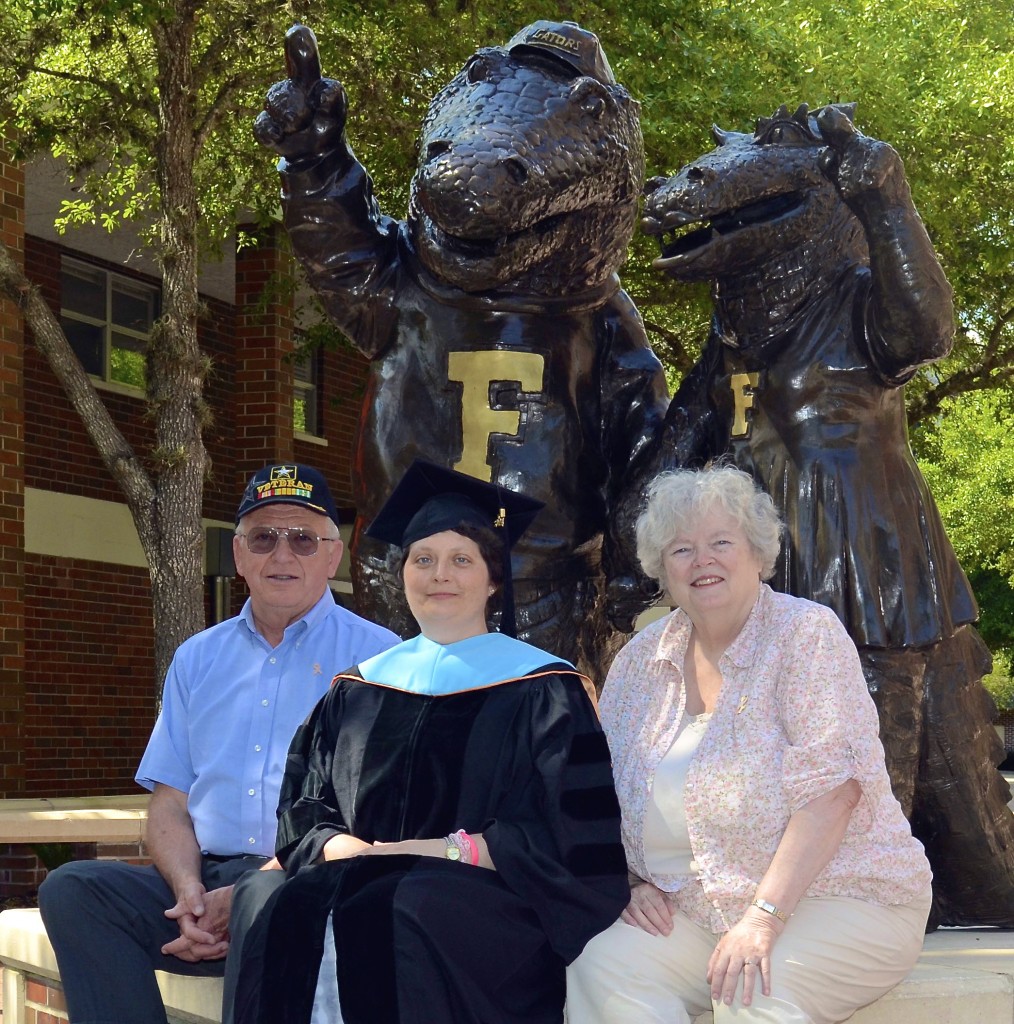
Jo Kenney, center, poses before her graduation ceremony with her parents Robert and Susan Kenney, in front of the statue of Gator mascots Albert and Alberta at UF’s Emerson Alumni Hall.
When Kenney was presented with an Ed.D. degree during the UF College of Education’s commencement on April 25 at the O’Connell Center, few people knew what the past 18 months had been like for the 41-year-old distance-learning student, who had just flown to Gainesville from San Antonio for the ceremony.
Kenney said “it hit me like a ton of bricks” when she was diagnosed with stage 2 breast cancer in February of 2013 — three years into her doctoral coursework at UF.
“Time stood still,” she said. “I was in shock.”
But Kenney regrouped, and she and her doctors mapped out a treatment strategy that would allow her to keep her civilian job with the Department of Defense at Fort Sam Houston and continue working on her dissertation and coursework.
“They told me 2013 was really going to suck, but then I’d be cured,” Kenney said.
After the first three of eight chemotherapy sessions, Kenney successfully defended her dissertation proposal via Skype.
A month later, she was asked to take over as interim head of the education technology department at the Medical Education and Training Campus — a joint military facility at Fort Sam Houston — when her boss of three years quit unexpectedly.
In June, Kenney’s grueling year got more “sucky” thanks to federal budget sequestration. For 11 weeks she had to take off one day unpaid each week. The subsequent government shutdown resulted in Kenney being furloughed in October, when she was home recovering from the double mastectomy she underwent in September.
“And that’s the short version of all that happened,” Kenney quipped. “There were times when I wasn’t trying to take things one day at a time. I was surviving from moment to moment.”
Through it all, she kept her eyes on the prize.
In March of this year, Kenney summoned the strength to fly to Gainesville and successfully defend her dissertation, titled The Future of Simulations in Allied Healthcare Education and Training: A Modified Delphi Study Identifying Their Instructional and Technical Feasibility.

Jo Kenney (center) poses with her family before UF’s commencement for doctoral graduates. Pictured with her in front row are her mother, Susan Kenney, and her aunt, Carolyn Barczc; back row are her brother, Jeff Kenney, and her father Robert Kenney.
“It’s very difficult to be articulate after you’ve had chemo,” she said. “My adviser and three other professors didn’t go easy on me, but they were patient. They gave me time to finish my sentences.”
Kenney also has maintained a blog during her ordeal. Titled “Bring It On: A Journey Through Breast Cancer, Dissertation and Life,” the blog (http://whyshoulditbeeasy.blogspot.com) proved to be a source of healing. Laced with humor and a multitude of inspirational quotes from well-known people, Kenney learned from her readers that she wasn’t alone.
“Survival is more than just putting one foot in front of the other,” she wrote on Feb. 7, 2013. “It’s laughing when you trip over your own feet. Laughter and friendship make even the worst days possible to deal with.”
Another entry — made exactly one year later — summarizes Kenney’s future plans.
“To face adversity and survive is wonderful,” she wrote. “But to use this journey to help others I think is the next part of the journey.”
Kenney says she is feeling stronger every day, and that she is taking spinning classes to build up her stamina.
“On a scale of 1-to-10, I’d give myself a 7 in terms of my overall health,” she said. “I’ll be on a maintenance drug for 10 years, but at least I have more control over my situation. Now I can turn this into something positive.
“I’m looking for my next challenge at this point, but I’ll take my time looking for the right fit. I’d like to be a manager of instructional design, or a director of learning technologies or educational technology and innovation. Something where I can help support and improve the student experience.”
CONTACTS
Writer: Stephen Kindland, UF College of Education, News & Communications, 352-273-4449, skindland@coe.ufl.edu
Media Relations: Larry Lansford, UF College of Education, News & Communications, 352-273-4449, llansford@coe.ufl.edu
COE researchers out in force at AERA’s massive annual meeting
(Click here for PDF listing of UFCOE presentations)
For years, the massive annual meeting of the American Educational Research Association has been a hotbed of the latest research and new ideas about teaching-and-learning practices and policies. This year, some 65 UF College of Education faculty and students participated in the 2013 meeting April 27-May 1 in San Francisco, joining 14,000 other education scholars from 75 nations.
This year’s meeting theme focused on the relationships of education and poverty—how education theory, research, policy and praxis contribute to alleviating economic, intellectual and moral poverty.
More UF education scholars, from multiple disciplines, attend AERA’s annual meeting than any other professional gathering. The EduGator contingent in San Francisco included 34 college faculty and 31 graduate students participating in presentations, panel discussions and association-related business meetings.
The UF presentations included hot education topics such as:
- The effect of charter schools on student achievement
- How neighborhoods contribute to children’s language and literacy development
- Games and simulation courses in education technology
- Analyzing the urban middle school transition and persistently disciplined students
- Does teacher preparation for English Language Learners matter?
- Leadership standards and accountability in Florida: Do they address poverty and social justice issues?
- Supply and demand context for special-education teacher preparation reform
- Writing instruction: What do preservice teachers know?
The busiest COE faculty attendees were Walter Leite and Mirka Koro-Ljungberg (both from research and evaluation methods), with four presentations each. Mary Brownell (special education), Ester de Jong (ESOL/bilingual education), Bernie Oliver (education leadership) and Albert Ritzhaupt (education technology) each made three presentations.
The complete AERA annual meeting program is available online at www.aera.net.
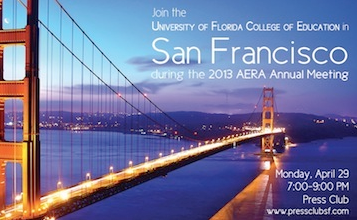
WRITER: Larry Lansford, director, news and communications, UF College of Education; llansford@coe.ufl.edu; 352-273-4137
International group cites Ed.D. graduate’s online-learning research
Julia Carpenter, a recent UF doctoral (Ed.D.) graduate in educational technology, has been awarded the Online Learning Innovator Award for Outstanding Research from iNACOL, the International Association for K-12 Online Learning, for her dissertation study on increasing student motivation and completion rates in online courses.
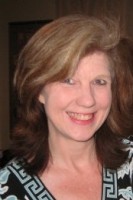 Motivation is key in virtual schooling, where students take an active role in their self-directed learning. Carpenter used a special “course-interest” survey instrument to poll 78 ninth-grade students in an online English course at Florida Virtual School. She found that the most motivating factors for online students were frequent instructor communication and constructive instructor feedback. She also discovered that experienced instructors more effectively built student confidence and satisfaction. Their expertise, she concluded, would be valuable in building professional training for novice online instructors.
Motivation is key in virtual schooling, where students take an active role in their self-directed learning. Carpenter used a special “course-interest” survey instrument to poll 78 ninth-grade students in an online English course at Florida Virtual School. She found that the most motivating factors for online students were frequent instructor communication and constructive instructor feedback. She also discovered that experienced instructors more effectively built student confidence and satisfaction. Their expertise, she concluded, would be valuable in building professional training for novice online instructors.
The iNACOL Online Learning Innovator Award is highly competitive, drawing some 30 entries from higher education institutions across the nation. Carpenter will accept her award at iNACOL’s Virtual School Symposium in Indianapolis on Nov. 9.
Carpenter graduated in August with her Ed.D. in educational technology as part of the first graduating class for the new online degree program in curriculum and instruction, with an emphasis in educational technology. She is a senior instructional systems designer at defense contractor General Dynamics’ information-technology unit in Orlando. UF’s education technology program also has appointed her as an adjunct instructor starting the spring semester.
Her research was supervised by Cathy Cavanaugh, UF associate professor in education technology, who has also received research awards from iNACOL. The international nonprofit group, based in Washington, D.C., has more than 3,800 members and works through advocacy, research and professional development to drive future directions in K-12 online education.
Ed tech scholar named to EU panel on lifelong learning
Catherine Cavanaugh, UF associate professor of education technology, has been named to the International Advisory Panel for the European Union’s Lifelong Learning Programme multi-year project examining innovative ICT-enhanced learning initiatives, http://www.virtualschoolsandcolleges.info/
Contact Us
College of Education
140 Norman Hall
PO Box 117040
Gainesville, FL 32611-7044
(352) 392-0726

